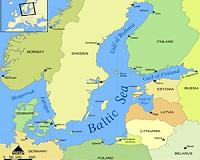| . |  |
. |
Durham, N.C. (UPI) Apr 19, 2011 Earth has more barrier islands, strips of sand parallel to a coast but separated from it by estuaries or lagoons, than previously thought, U.S. researchers say. Scientists at Duke University and Meredith College used satellite images, topographical maps and navigational charts to identify a total of 2,149 of the offshore deposits of sand and sediment, a significant increase of the 1,492 counted in 2001 before the public availability of satellite imagery. All told, the 2,149 barrier islands measure 12,913 miles in length, and are found along all the continents except Antarctica and in all oceans, a Duke release said Tuesday. Taken together, barrier islands make up roughly 10 percent of the Earth's continental shorelines, the researchers said. Barrier islands help protect low-lying mainland coasts from erosion and storm damage and can be important wildlife habitats. Unlike stationary coastal land forms, barrier islands build up, erode, migrate and rebuild over time in response to waves, tides, currents and other physical processes in the open ocean environment, the researchers said. The survey results have been published in the Journal of Coastal Research. "This provides proof that barrier islands exist in every climate and in every tide-wave combination," Duke geology professor Orrin H. Pilkey said. "We found that everywhere there is a flat piece of land next to the coast, a reasonable supply of sand, enough waves to move sand or sediment about, and a recent sea-level rise that caused a crooked shoreline, barrier islands exist."
Share This Article With Planet Earth
Related Links Water News - Science, Technology and Politics
 Oxygenation At A Depth Of 120 Meters Can Save The Baltic Sea
Oxygenation At A Depth Of 120 Meters Can Save The Baltic SeaGothenburg, Sweden (SPX) Apr 20, 2011 Oxygenation brings dead sea bottoms to life. This creates the necessary conditions for the establishment of new ecosystems that enable nature itself to deal with eutrophication. By conducting pilot studies in two fjords in Sweden, researchers at the University of Gothenburg have demonstrated that pumping oxygen-rich surface water down to sea bottoms is effective. A large wind-driven pump is now ... read more |
|
| The content herein, unless otherwise known to be public domain, are Copyright 1995-2010 - SpaceDaily. AFP and UPI Wire Stories are copyright Agence France-Presse and United Press International. ESA Portal Reports are copyright European Space Agency. All NASA sourced material is public domain. Additional copyrights may apply in whole or part to other bona fide parties. Advertising does not imply endorsement,agreement or approval of any opinions, statements or information provided by SpaceDaily on any Web page published or hosted by SpaceDaily. Privacy Statement |